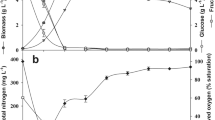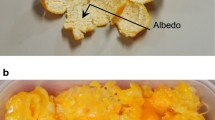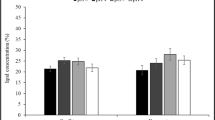Abstract
The usage of the citrus wastes for strategic valorization is a concept for the production of various commercial products. Wastes from citrus fruits have a considerate amount of sugar and limonene. In the present work, partially removed limonene from hydrolysed orange peel was used for supplementation as carbon source in minimal media for the production of ethanol. A novel yeast strain, Saccharomyces cerevisiae strain BT1 (MK373758) was isolated from Toddy, obtained from Borassus flabellifer (toddy palm), Bhatan, Mumbai. This strain was used in the formulated fermentation media for the production of bioethanol. Optimization of critical parameters was done for pH, temperature and time of fermentation vs production of bioethanol. The Brix, pH, sugar content and ethanol content were measured during the fermentation process. The ethanol content was estimated by dichromate method and high performance liquid chromatography (HPLC) and the yield obtained was 0.95%. In addition, limonene was also extracted from hydrolysed orange peel and estimated by gas chromatography-flame ionization detection (GC-FID) and was found to be 0.4% (v/v). The two valuable products, bioethanol, and d-limonene, obtained from orange peel waste, promises its valorisation at a larger scale.
Graphical abstract






Similar content being viewed by others
References
Absher M (1973) Hemocytometer counting. In: Kruse PF Jr, Patterson MK Jr (eds) Tissue culture: methods and applications. Academic Press, New York, pp 395–397
Ahmad Z, Asgher M, Iqbal HMN (2017) Enzyme treated wheat straw based PVOH: development and characterization. BioResources 12(2):2830–2845
Arevalo-Gallegos A, Ahmad Z, Asgher M, Parra-Saldivar R, Iqbal HMN (2017) Lignocellulose: a sustainable material to produce value-added products with a zero waste approach—a review. Int J Biol Macromol 99:308–318
Asgher M, Ahmad Z, Iqbal HMN (2017) Bacterial cellulose assisted de-lignified wheat straw-PVA based biocomposites with novel characteristics. Carbohyd Polym 161:244–252
Bilal M, Asgher M, Iqbal HMN, Hu H, Zhang X (2017) Biotransformation of lignocellulosic materials into value-added products—a review. Int J Biol Macromol 98:447–458
Bio-Rad Laboratories Inc. (2012) Chromatography Aminex HPLC columns. http://www.bio-rad.com/webroot/web/pdf/lsr/literature/Bulletin_6333.pdf
Bousbia N, Vian MA, Ferhat MA, Meklati BY, Chemat F (2009) A new process for extraction of essential oil from citrus peels: microwave hydrodiffusion and gravity. J Food Eng 90:409–413
Brokl M, Hernández-Hernández O, Soria AC, Sanz ML (2011) Evaluation of different operation modes of high performance liquid chromatography for the analysis of complex mixtures of neutral oligosaccharides. J Chromatogr A 1218(42):7697–7703
Calabro PS, Folino A, Tamburino V, Zappia G, Zema DA, Zimbome SM (2017) Valorisation of citrus processing waste: review. Proceedings Sardinia 2017/16th international waste management and landfill symposium. S. Margherita di Pula, Cagliari, pp 1–42
Davidowski S, DiMarco B (2009) The extraction and quantification of limonene from citrus rinds using GC/MS, 1st edn [ebook]. Perkinelmer, Waltham, pp 1–3
Erasto P, Viljoen AM (2008) Limonene: biosynthetic, ecological and pharmacological relevance. Nat Prod Commun 3:1193–1202
Ezejiofor TLN, Eke NV, Okechukwu RI, Nwoguikpe RN, Duru CM (2011) Waste to wealth: industrial raw materials potential of peels of Nigerian sweet orange (Citrus sinensis). Afr J Biotechnol 10(33):6257–6264
Giwa SO, Muhammad M, Giwa A (2018) Utilizing orange peels for essential oil production. J Eng Appl Sci 13(1):17–27
Iqbal HMN, Kyazze G, Keshavarz T (2017) Advances in the valorization of lignocellulosic materials by biotechnology: an overview. BioResources 8(2):3157–3176
Irfan M, Nadeem M, Syed Q (2014) Ethanol production from agricultural wastes using Saccharomyces cerevisiae. Braz J Microbiol 45(2):457–465
John I, Muthukumar K, Arunagiri A (2017) A review on the potential of citrus waste for d-limonene, pectin, and bioethanol production. Int J Green Energy 14(7):599–612
Joshi SM, Waghmare JS, Sonawane KD, Waghmare SR (2015) Bio-ethanol and bio-butanol production from orange peel waste. Biofuels 6(1–2):55–61
Karr LL, Coats JR (1988) Insecticidal properties of d-limonene. J Pesticide Sci 13:287–290
Lin CSK, Pfaltzgraff LA, Herrero-Davila L, Mubofu EB, Abderrahim S, Clark JH, Koutinas AA, Kopsahelis N, Stamatelatou K, Dickson F, Thankappan S, Mohamed Z, Brocklesby R, Luque R (2013) Food waste as a valuable resource for the production of chemicals, materials and fuels. Current situation and global perspective. Energy Environ Sci 6(2):426–464
Marín FR, Soler-Rivas C, Benavente-García O, Castillo J, Pérez-Alvarez JA (2007) By-products from different citrus processes as a source of customized functional fibres. Food Chem 100(2):736–741
McBee GC, Maness NO (1983) Determination of sucrose, glucose, and fructose in plant tissue by high-performance liquid chromatography. J Chromatogr 264:474
Miller GL (1959) Use of dinitrosalicylic acid reagent for determination of reducing sugar. Anal Chem 31:426
Mirabella N, Castellani V, Sala S (2014) Current options for the valorization of food manufacturing waste: a review. J Clean Prod 65:28–41
Mishra J, Kumar D, Samanta S, Vishwakarma KM (2012) A comparative study of ethanol production from various agro residues by using Saccharomyces cerevisiae and Candida albicans. J Yeast Fungal Res 3(2):12–17
Mondello L, Casilli A, Tranchida PQ, Costa R, Dugo P, Dugo G (2004) Fast GC for the analysis of citrus oils. J Chromatogr Sci 42(8):410–416
Mrudula S, Anitharai R (2011) Pectinase production in solid state fermentation by Aspergillus niger using orange peel as substrate. Glob J Biotechnol Biochem 6:64–71
Oberoi HS, Vadlani PV, Madl RL, Saida L, Abeykoon JP (2010) Ethanol production from orange peels: two-stage hydrolysis and fermentation studies using optimized parameters through experimental design. J Agric Food Chem 58(6):3422–3429
Ohgren K, Bengtsson O, Gorwa-Grauslund MF, Galbe M, Hahn-Hägerdal B, Zacchi G (2006) Simultaneous saccharification and co-fermentation of glucose and xylose in steam-pretreated corn stover at high fiber content with Saccharomyces cerevisiae TMB3400. J Biotechnol 126(4):488–498
Santi G, Crognale S, D’Annibale A, Petruccioli M, Ruzzi M, Valentini R, Moresi M (2014) Orange peel pretreatment in a novel lab-scale direct steam-injection apparatus for ethanol production. Biomass Bioenerg 61:146–156
Strober W (2015) Trypan blue exclusion test of cell viability. Curr Protoc Immunol 2:111 A3.B.1-3
The Daily Records (2018) Top 10 largest citrus producing countries in the world. http://www.thedailyrecords.com/2018-2019-2020-2021/world-famous-top-10-list/world/largest-citrus-producing-countries-world-statistics-states/6867/
Tracy NI, Chen D, Crunkleton DW, Price GL (2009) Hydrogenated monoterpenes as diesel fuel additives. Fuel 88(11):2238–2240
USDA (2008) “US. Biobased Products: Market Potential and Projections Through 2025”. Office of the chief Economist, Office of Energy Policy and New Uses, U.S. Department of Agriculture
USDA (2018) Citrus: world markets and trade, pp 1–2. https://www.fas.usda.gov/data/citrus-world-markets-and-trade
Vlysidis A, Koutinas A, Kookos I (2017) Techno-economic evaluation of refining of food supply chain wastes for the production of chemicals and biopolymers. In: Morone P, Papendiek F, Tartiu VE (eds) Food waste reduction and valorisation :sustainability assessment and policy analysis. Springer, New York, pp 166–167
Wilkins MR (2009) Effect of orange peel oil on ethanol production by Zymomonas mobilis. Biomass Bioenerg 3(3):538–541
Wilkins MR, Suryawati L, Maness NO et al (2007) Ethanol production by Saccharomyces cerevisiae and Kluyveromyces marxianus in the presence of orange-peel oil. World J Microbiol Biotechnol 23:1161
Wysocka J, Doskocz J, Haller P, Kardasz P, Jaworska E (2015) The use of alcohols and their compounds as biofuel and gasoline blends. J Civ Environ Eng 5:187
Zhou W, Widmer W, Grohmann K (2007) Economic analysis of ethanol production from citrus peel waste. In: Proceedings of the Florida State Horticultural Society, vol 120, pp 310–315
Author information
Authors and Affiliations
Corresponding author
Ethics declarations
Conflict of interest
The authors declare that there is no conflict of interest.
Additional information
Publisher's Note
Springer Nature remains neutral with regard to jurisdictional claims in published maps and institutional affiliations.
Rights and permissions
About this article
Cite this article
Jha, P., Singh, S., Raghuram, M. et al. Valorisation of orange peel: supplement in fermentation media for ethanol production and source of limonene. Environmental Sustainability 2, 33–41 (2019). https://doi.org/10.1007/s42398-019-00048-2
Received:
Revised:
Accepted:
Published:
Issue Date:
DOI: https://doi.org/10.1007/s42398-019-00048-2




